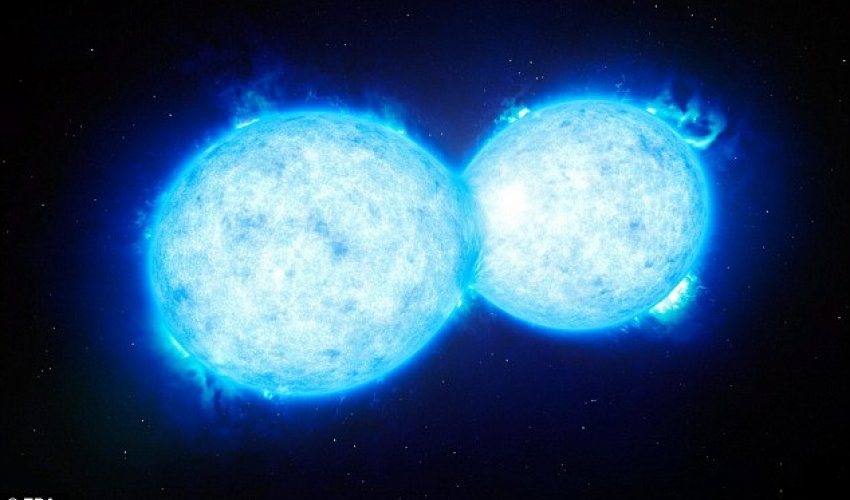The kiss of DEATH

Astronomers have discovered the hottest and most massive double star system to date where the two components are in contact and sharing material.
The European Southern Observatory (ESO) says the system, named VFTS 352, lies about 160,000 light-years from Earth in the Large Magellanic Cloud.
It could be heading for a dramatic end, either merging to form a single giant star or forming a binary black hole.
VFTS 352 is composed of two very hot, bright and massive stars that orbit each other in little more than a day.
The centres of the stars are separated by just 7.5 million miles (12 million km) .
The stars are so close that their surfaces overlap and a bridge has formed between them.
VFTS 352 is not only the most massive known in this tiny class of 'overcontact binaries' — it has a combined mass of about 57 times that of the sun — but it also contains the hottest components — with surface temperatures above 40,000°C.
In the case of VFTS 352, however, both stars in the system are of almost identical size.
Material is therefore not sucked from one to another, but instead may be shared.
The component stars of VFTS 352 are estimated to be sharing about 30 per cent of their material.
Such a system is very rare because this phase in the life of the stars is short, making it difficult to catch them in the act.
Because the stars are so close together, astronomers believe that strong tidal forces lead to enhanced mixing of the material in the stellar interiors.
'The VFTS 352 is the best case yet found for a hot and massive double star that may show this kind of internal mixing,' explains lead author Leonardo Almeida of the University of São Paulo, Brazil. 'As such it's a fascinating and important discovery.'
Astronomers predict that VFTS 352 will face a cataclysmic fate in one of two ways.
The first potential outcome is the merging of the two stars, which would likely produce a rapidly rotating, and possibly magnetic, gigantic single star.
'If it keeps spinning rapidly it might end its life in one of the most energetic explosions in the universe, known as a long-duration gamma-ray burst,' says the lead scientist of the project, Hugues Sana, of the University of Leuven in Belgium.
The second possibility is explained by the lead theoretical astrophysicist in the team, Selma de Mink of University of Amsterdam: 'If the stars are mixed well enough, they both remain compact and the VFTS 352 system may avoid merging.
'This would lead the objects down a new evolutionary path that is completely different from classic stellar evolution predictions. In the case of VFTS 352, the components would likely end their lives in supernova explosions, forming a close binary system of black holes.
'Such a remarkable object would be an intense source of gravitational waves.'
Proving the existence of this second evolutionary path would be an observational breakthrough in the field of stellar astrophysics.
But, regardless of how VFTS 352 meets its demise, this system has already provided astronomers with valuable new insights into the poorly understood evolutionary processes of massive overcontact binary star systems.
(dailymail.co.uk)
www.ann.az
Similar news
Similar news
Latest news 
More news 



































 Photo
Photo 



 Video
Video 

